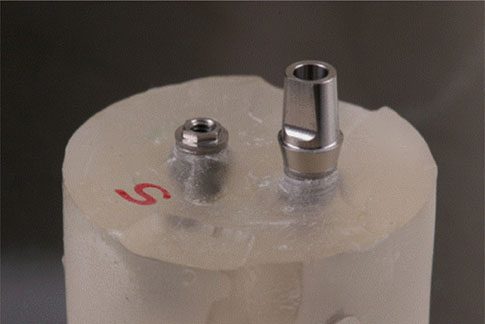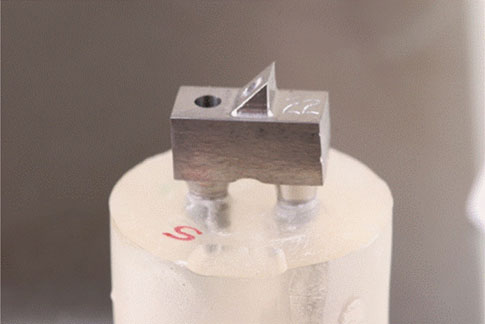J Adv Prosthodont.
2015 Jun;7(3):207-213. 10.4047/jap.2015.7.3.207.
Effect of cement washout on loosening of abutment screws and vice versa in screw- and cement- retained implant-supported dental prosthesis
- Affiliations
-
- 1Department of Prosthodontics, Samsung Medical Center, College of Medicine, Sungkyunkwan University, Seoul, Republic of Korea.
- 2Department of Prosthodontics, College of Dentistry, Chosun University, Gwangju, Republic of Korea. jhajung@chosun.ac.kr
- KMID: 2284706
- DOI: http://doi.org/10.4047/jap.2015.7.3.207
Abstract
- PURPOSE
The purpose of this study was to examine the abutment screw stability of screw- and cement-retained implant-supported dental prosthesis (SCP) after simulated cement washout as well as the stability of SCP cements after complete loosening of abutment screws.
MATERIALS AND METHODS
Thirty-six titanium CAD/CAM-made implant prostheses were fabricated on two implants placed in the resin models. Each prosthesis is a two-unit SCP: one screw-retained and the other cemented. After evaluating the passive fit of each prosthesis, all implant prostheses were randomly divided into 3 groups: screwed and cemented SCP (Control), screwed and noncemented SCP (Group 1), unscrewed and cemented SCP (Group 2). Each prosthesis in Control and Group 1 was screwed and/or cemented, and the preloading reverse torque value (RTV) was evaluated. SCP in Group 2 was screwed and cemented, and then unscrewed (RTV=0) after the cement was set. After cyclic loading was applied, the postloading RTV was measured. RTV loss and decementation ratios were calculated for statistical analysis.
RESULTS
There was no significant difference in RTV loss ratio between Control and Group 1 (P=.16). No decemented prosthesis was found among Control and Group 2.
CONCLUSION
Within the limits of this in vitro study, the stabilities of SCP abutment screws and cement were not significantly changed after simulated cement washout or screw loosening.
MeSH Terms
Figure
Reference
-
1. Hebel KS, Gajjar RC. Cement-retained versus screw-retained implant restorations: achieving optimal occlusion and esthetics in implant dentistry. J Prosthet Dent. 1997; 77:28–35.2. Chee W, Felton DA, Johnson PF, Sullivan DY. Cemented versus screw-retained implant prostheses: which is better? Int J Oral Maxillofac Implants. 1999; 14:137–141.3. Taylor TD, Belser U, Mericske-Stern R. Prosthodontic considerations. Clin Oral Implants Res. 2000; 11:101–107.4. Taylor TD, Agar JR, Vogiatzi T. Implant prosthodontics: current perspective and future directions. Int J Oral Maxillofac Implants. 2000; 15:66–75.5. Taylor TD, Agar JR. Twenty years of progress in implant prosthodontics. J Prosthet Dent. 2002; 88:89–95.6. Michalakis KX, Hirayama H, Garefis PD. Cement-retained versus screw-retained implant restorations: a critical review. Int J Oral Maxillofac Implants. 2003; 18:719–728.7. Heckmann SM, Karl M, Wichmann MG, Winter W, Graef F, Taylor TD. Cement fixation and screw retention: parameters of passive fit. An in vitro study of three-unit implant-supported fixed partial dentures. Clin Oral Implants Res. 2004; 15:466–473.8. Vigolo P, Givani A, Majzoub Z, Cordioli G. Cemented versus screw-retained implant-supported single-tooth crowns: a 4-year prospective clinical study. Int J Oral Maxillofac Implants. 2004; 19:260–265.9. Wood MR, Vermilyea SG. Committee on Research in Fixed Prosthodontics of the Academy of Fixed Prosthodontics. A review of selected dental literature on evidence-based treatment planning for dental implants: report of the Committee on Research in Fixed Prosthodontics of the Academy of Fixed Prosthodontics. J Prosthet Dent. 2004; 92:447–462.10. Taylor PA. Incorporating retrievability in fixed implant-supported prostheses by transverse fixation in the ITI abutment system. J Can Dent Assoc. 2004; 70:459–463.11. Clausen GF. The lingual locking screw for implant-retained restorations-aesthetics and retrievability. Aust Prosthodont J. 1995; 9:17–20.12. McGlumphy EA, Mendel DA, Holloway JA. Implant screw mechanics. Dent Clin North Am. 1998; 42:71–89.13. Keith SE, Miller BH, Woody RD, Higginbottom FL. Marginal discrepancy of screw-retained and cemented metal-ceramic crowns on implants abutments. Int J Oral Maxillofac Implants. 1999; 14:369–378.14. Guichet DL, Caputo AA, Choi H, Sorensen JA. Passivity of fit and marginal opening in screw- or cement-retained implant fixed partial denture designs. Int J Oral Maxillofac Implants. 2000; 15:239–246.15. Preiskel HW, Tsolka P. Telescopic prostheses for implants. Int J Oral Maxillofac Implants. 1998; 13:352–357.16. Lindström H, Preiskel H. The implant-supported telescopic prosthesis: a biomechanical analysis. Int J Oral Maxillofac Implants. 2001; 16:34–42.17. Preiskel HW, Tsolka P. Cement- and screw-retained implant-supported prostheses: up to 10 years of follow-up of a new design. Int J Oral Maxillofac Implants. 2004; 19:87–91.18. Kim SG, Park JU, Jeong JH, Bae C, Bae TS, Chee W. In vitro evaluation of reverse torque value of abutment screw and marginal opening in a screw- and cement-retained implant fixed partial denture design. Int J Oral Maxillofac Implants. 2009; 24:1061–1067.19. Karl M, Winter W, Taylor TD, Heckmann SM. In vitro study on passive fit in implant-supported 5-unit fixed partial dentures. Int J Oral Maxillofac Implants. 2004; 19:30–37.20. Guichet DL, Caputo AA, Choi H, Sorensen JA. Passivity of fit and marginal opening in screw- or cement-retained implant fixed partial denture designs. Int J Oral Maxillofac Implants. 2000; 15:239–246.21. Papavasiliou G, Tripodakis AP, Kamposiora P, Strub JR, Bayne SC. Finite element analysis of ceramic abutment-restoration combinations for osseointegrated implants. Int J Prosthodont. 1996; 9:254–260.22. Cantwell A, Hobkirk JA. Preload loss in gold prosthesis-retaining screws as a function of time. Int J Oral Maxillofac Implants. 2004; 19:124–132.23. Jörnéus L, Jemt T, Carlsson L. Loads and designs of screw joints for single crowns supported by osseointegrated implants. Int J Oral Maxillofac Implants. 1992; 7:353–359.24. Haack JE, Sakaguchi RL, Sun T, Coffey JP. Elongation and preload stress in dental implant abutment screws. Int J Oral Maxillofac Implants. 1995; 10:529–536.25. Bickford JH. Introduction to assembly. In : Bickford JH, editor. An Introduction to the Design and Behaviour of Bolted Joints. 3rd ed. New York: Marcel Dekker;1995. p. 175–212.26. Tzenakis GK, Nagy WW, Fournelle RA, Dhuru VB. The effect of repeated torque and salivary contamination on the preload of slotted gold implant prosthetic screws. J Prosthet Dent. 2002; 88:183–191.27. Binon PP, McHugh MJ. The effect of eliminating implant/abutment rotational misfit on screw joint stability. Int J Prosthodont. 1996; 9:511–519.28. Byrne D, Houston F, Cleary R, Claffey N. The fit of cast and premachined implant abutments. J Prosthet Dent. 1998; 80:184–192.29. Rangert B, Jemt T, Jörneus L. Forces and moments on Branemark implants. Int J Oral Maxillofac Implants. 1989; 4:241–247.30. Siamos G, Winkler S, Boberick KG. Relationship between implant preload and screw loosening on implant-supported prostheses. J Oral Implantol. 2002; 28:67–73.31. Khraisat A, Hashimoto A, Nomura S, Miyakawa O. Effect of lateral cyclic loading on abutment screw loosening of an external hexagon implant system. J Prosthet Dent. 2004; 91:326–334.32. Merz BR, Hunenbart S, Belser UC. Mechanics of the implant-abutment connection: an 8-degree taper compared to a butt joint connection. Int J Oral Maxillofac Implants. 2000; 15:519–526.33. Kitamura E, Stegaroiu R, Nomura S, Miyakawa O. Biomechanical aspects of marginal bone resorption around osseointegrated implants: considerations based on a three-dimensional finite element analysis. Clin Oral Implants Res. 2004; 15:401–412.34. Graf H. Bruxism. Dent Clin North Am. 1969; 13:659–665.35. Ongthiemsak C, Mekayarajjananonth T, Winkler S, Boberick KG. The effect of compressive cyclic loading on retention of a temporary cement used with implants. J Oral Implantol. 2005; 31:115–120.36. Mericske-Stern R, Zarb GA. In vivo measurements of some functional aspects with mandibular fixed prostheses supported by implants. Clin Oral Implants Res. 1996; 7:153–161.37. Gervais MJ, Wilson PR. A rationale for retrievability of fixed, implant-supported prostheses: a complication-based analysis. Int J Prosthodont. 2007; 20:13–24.38. Binon PP. Evaluation of machining accuracy and consistency of selected implants, standard abutments, and laboratory analogs. Int J Prosthodont. 1995; 8:162–178.39. Binon PP. The effect of implant/abutment hexagonal misfit on screw joint stability. Int J Prosthodont. 1996; 9:149–160.40. Burguete RL, Johns RB, King T, Patterson EA. Tightening characteristics for screwed joints in osseointegrated dental implants. J Prosthet Dent. 1994; 71:592–599.41. Sakaguchi RL, Borgersen SE. Nonlinear contact analysis of preload in dental implant screws. Int J Oral Maxillofac Implants. 1995; 10:295–302.42. Aboyoussef H, Weiner S, Ehrenberg D. Effect of an antirotation resistance form on screw loosening for single implant-supported crowns. J Prosthet Dent. 2000; 83:450–455.43. Tan BF, Tan KB, Nicholls JI. Critical bending moment of implant-abutment screw joint interfaces: effect of torque levels and implant diameter. Int J Oral Maxillofac Implants. 2004; 19:648–658.44. Duyck J, Van Oosterwyck H, Vander Sloten J, De Cooman M, Puers R, Naert I. Pre-load on oral implants after screw tightening fixed full prostheses: an in vivo study. J Oral Rehabil. 2001; 28:226–233.45. Patterson EA, Johns RB. Theoretical analysis of the fatigue life of fixture screws in osseointegrated dental implants. Int J Oral Maxillofac Implants. 1992; 7:26–33.46. Jaarda MJ, Razzoog ME, Gratton DG. Geometric comparison of five interchangeable implant prosthetic retaining screws. J Prosthet Dent. 1995; 74:373–379.47. Wolfart M, Wolfart S, Kern M. Retention forces and seating discrepancies of implant-retained castings after cementation. Int J Oral Maxillofac Implants. 2006; 21:519–525.48. Mehl C, Harder S, Wolfart M, Kern M, Wolfart S. Retrievability of implant-retained crowns following cementation. Clin Oral Implants Res. 2008; 19:1304–1311.49. Singer A, Serfaty V. Cement-retained implant-supported fixed partial dentures: a 6-month to 3-year follow-up. Int J Oral Maxillofac Implants. 1996; 11:645–649.50. Keller W, Brägger U, Mombelli A. Peri-implant microflora of implants with cemented and screw retained suprastructures. Clin Oral Implants Res. 1998; 9:209–217.
- Full Text Links
- Actions
-
Cited
- CITED
-
- Close
- Share
- Similar articles
-
- Clinical evaluation of retained preload and cement washout in screw- and cement-retained implant prosthesis
- A new retaining method of cement-retained restoration with linguo-horizontal insertion of fiber post
- Burnishing effect on marginal misfit of implant-supported screw-and-cement retained prostheses: A case report
- Clinical cases of implant-supported fixed dental prosthesis using modified lingual screw system (T-screw system)
- The incidence of the abutment screw loosening and its affecting factors in posterior implant restorations






